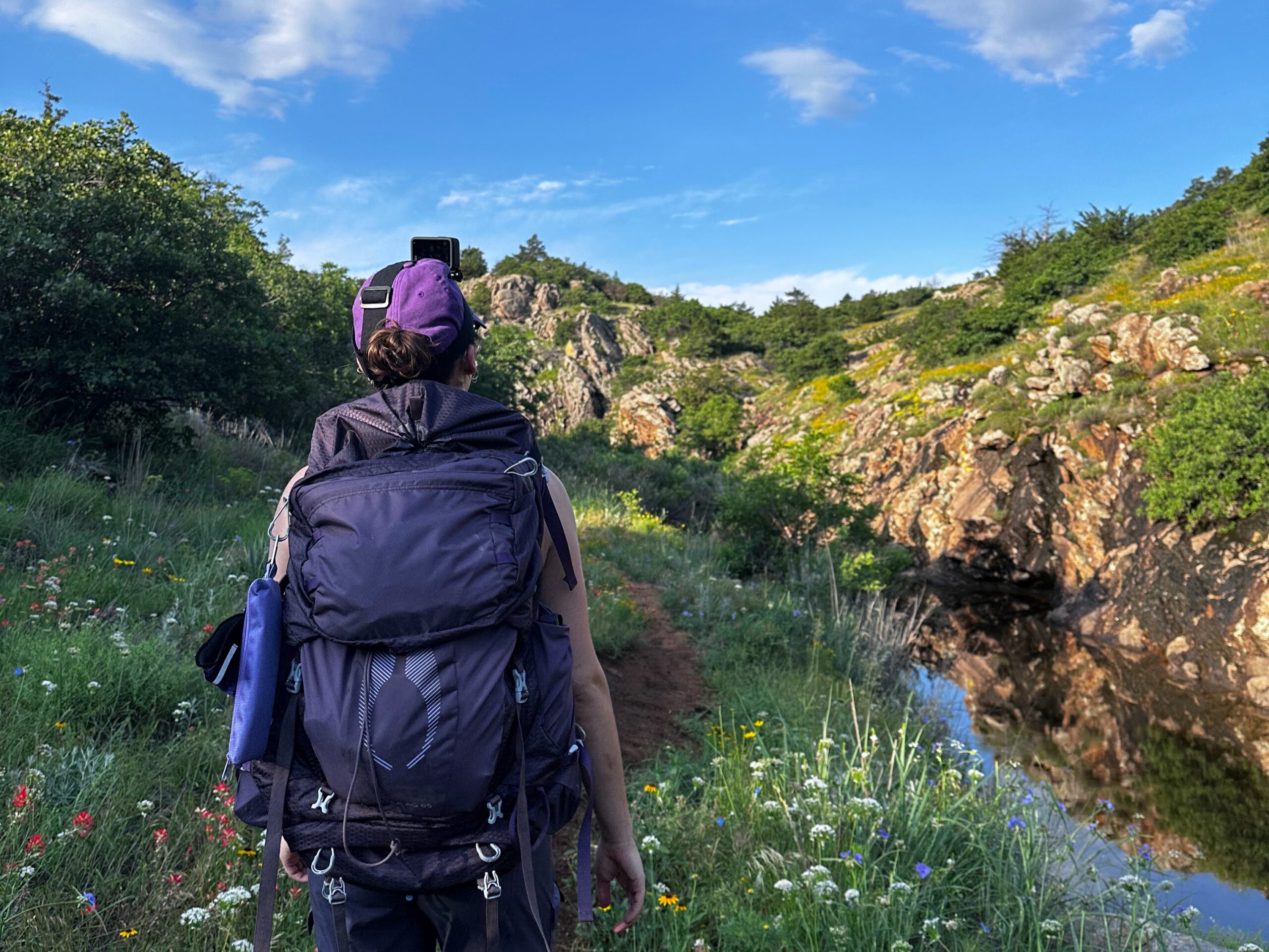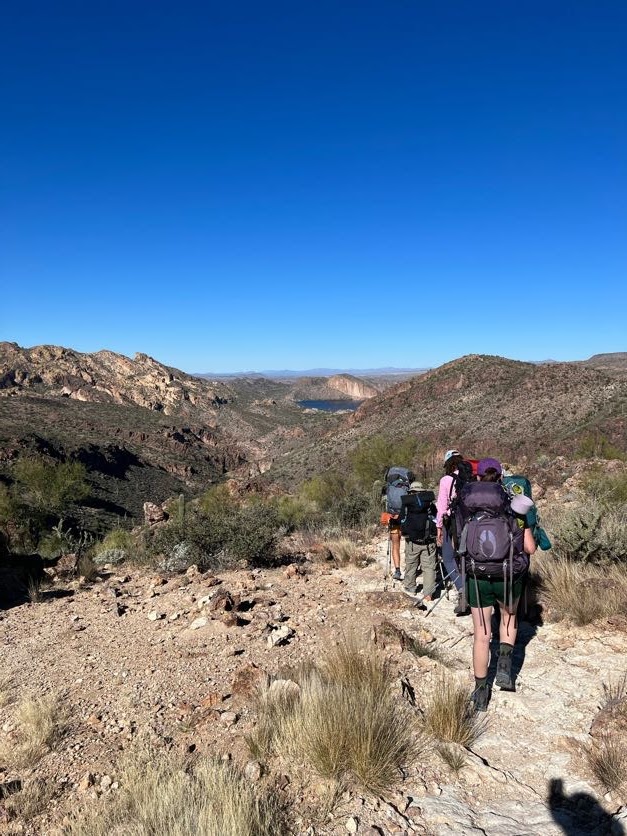A comprehensive day hiking checklist for any setting. This list is great to use for a shorter hike as well as an entire day out on the trails. For multi-day trips, you can add gear from the backpacking checklist.
I designed this day hike checklist for everyone who prefers to have an easy-to-access document at all times. You can download this checklist as a PDF/PNG/JPG. You can even print it out for the satisfaction of checking off the boxes as you pack!

| Clothing | Gear | Personal Items | Health / Safety | Food |
| Sun-Protective Hat | Day Pack | Phone | Sunscreen | Snacks |
| Hiking Shirt / Base Layer | Trekking Poles | Identification | SPF-Rated Lip Balm | Drink Mixes |
| Hiking Pants / Shorts | Winter Traction Devices | Itinerary | Insect Repellant | Trash Bag |
| Rain Jacket / Windbreaker | First-Aid Kit | Headphones | Lighter | |
| Insulated Jacket | Pocket Knife / Multi-tool | Chargers | Whistle | |
| Socks | Water Bottle / Reservoir | Portable Battery Pack | Bear Spray | |
| Hiking Shoes | Water Treatment Supplies | Emergency Contacts | Hand Sanitizer | |
| Gaiters | Headlamp | Menstrual Products | ||
| Sunglasses | Navigation Tools | Bathroom Products | ||
| Gloves / Mittens | Satellite Messenger | Prescription Medication | ||
| Bandana / Buff | Gear Repair Kit | Hand Wipes |
Clothing
Sun-Protective Hat – Sun-protective hats are not entirely necessary, but there are many hikers out there who would HATE to leave their hat at home. There are many different hats on the market, each with their own special features. Some hats are ultralight and ultra-packable, while others have special ventilation and neck-covering designs. Shop around online, and consider going to your local adventure store to make sure you find your perfect fit. Hiking hats can last years or even decades – especially those made with high-quality materials. If you don’t want a hiking hat, you can opt for alternative sun protection such as sunscreen and SPF-rated hiking hoodies.
Hiking Shirt / Base Layer – Hiking shirts and base layers are both important to pack, most importantly when you are adventuring in a cool or unpredictable climate. Although it’s easy to wear your favorite cotton tee for the hike, there are better options out there. The two most popular material options for this clothing are synthetic fibers (polyester or nylon) and merino wool. They both are quick-drying and moisture-wicking materials, which is great for any physical challenge. Both are also comparably thin, which makes them perfect for ultralight packers and backpacking in general. It’s best practice to start off hiking with multiple layers and peel them off as you heat up.
Hiking Pants / Shorts – Having a good pair of hiking pants or shorts on your hiking checklist can change the game. Some hiking pants even have a zipper that allows you to remove the bottom and turn them into shorts! Hiking bottoms are often made of synthetic materials. You can also simply pack some everyday leggings or shorts that you would be comfortable hiking in. If you’re not in a place to invest in new hiking clothes, it’s okay to wear what you have and what works best for you.

Rain Jacket / Windbreaker – It’s always a good idea to pack a non-insulated jacket for your day hike. Rain jackets are one of the best options for keeping you dry, while windbreakers will only protect you from the wind. Windbreakers are usually much lighter than rain jackets, but they won’t be as water-resistant (of course). When the weather gets too cold, hikers will replace windbreakers with an insulated jacket of some kind. If you’re planning to be in an extremely wet environment, you may want to consider bringing a pair of waterproof pants as well.
Insulated Jacket – You can find a good insulated jacket at any price point. You can even thrift one! When you’re just day-hiking, any cool-weather jacket should be just fine. If you’re hoping to have a jacket that works for both day hikes and overnight trips, there are a few things to consider. There are different types of insulation, varying levels of packability, and different temperature ratings for each jacket on the market. Insulated jackets will typically be stuffed with down or synthetic insulation. Down jackets are usually warmer, more lightweight, and more packable than insulated jackets. However, they do require more upkeep and care and are on the more expensive side. Synthetic jackets are more durable and long-lasting, as well as lower in cost overall.
Socks – Is it surprising to you that socks play a huge role in your hiking success? For shorter hikes, it matters slightly less what type of socks you wear. However, hiking socks are designed to keep your feet as healthy as possible during and after a long day hike (or multi-day hike). The goal of a good sock is to keep your feet dry because moisture will lead to blisters and skin irritation. You want a sock that will not absorb sweat but instead dry as quickly as possible – even while you’re still on the trail. Wool and synthetic materials are, again, the most popular materials for socks.

Hiking Shoes – Hiking shoes are a big investment! It’s tough to make a decision when there are hundreds of options online. First, you need to decide between hiking shoes, hiking boots, and backpacking boots. The higher the shoe goes up your ankle, the more supportive it tends to be. Although hiking shoes won’t be as supportive as hiking boots, they will weigh less and require less energy to wear. Some shoes are water-resistant, while others are not. It really depends on the kinds of hikes you plan to be doing. Many boots are also designed to be compatible with crampons, or winter-weather traction gear. This might be something you’ll want to consider when buying your ideal hiking shoe.
Gaiters – Gaiters are one of the best hiking checklist items for preventing dirt, snow, rocks, or anything small and irritating from getting into your shoes. They come in different lengths and designs for any scenario you might encounter outdoors. Waterproof gaiters will keep your shoes and socks from getting wet on the interior of the shoe – which is crucial for longer hikes. You can buy lightweight gaiters for trail running. Companies design them to keep rocks, burrs, and other debris from digging into your shoe as you run. If you’re not sure which pair of gaiters to pack, think about the terrain and possible obstacles you will encounter on trail.
Sunglasses – Sunglasses are another very important piece of sun-protection gear. Sunscreen and SPF-rated clothing can protect your skin, but sunglasses are the only things that can keep your eyes safe outdoors. Some are designed to be ultralight, while others float and are meant to be worn in the water. You want to buy a pair of sunglasses that will still let you see the beautiful outdoor landscapes. When it comes to a day hiking checklist, you also want glasses that are scratch-resistant and durable. If you are going to be near snow, you definitely want glasses that can protect you from snow blindness. Before you invest in a pair of hiking glasses, think about all of the factors mentioned above and decide what is most relevant to you.

Gloves / Mittens – Although you probably will not be packing hiking gloves for every single day hike, it’s still necessary to save a spot on the hiking checklist for them. Forget your gloves, and you’re very unlikely to enjoy the rest of the hike at all. In my opinion, gloves are one of the hardest things to shop for. It really takes a lot of trial and error to find the perfect pair. You need gloves (or mittens) that keep your hands warm, but not too sweaty. You want padding, but you also want to maintain dexterity with your hands. If you want the freedom of movement that comes with wearing gloves, but you also want to stay cozy, glove/mitten combos are a great option!
Bandana / Buff – Hiking bandanas, buffs, or bandeaus are fantastic accessories to have on this hiking checklist. They’re multi-functional, lightweight, and take up almost no room at all. You can use them to protect your head or neck from the sun, absorb sweat, and even keep dirt and cold air from entering your nose or mouth. I purchased a few buffs back in university and they have lasted for years without any wear showing at all. It’s easy to wrap one around your neck at the beginning of a hike and use it as needed. If it’s so cold and windy that your nose burns when you breathe, you can cover your lower face to solve the problem easily. While technically unnecessary, buffs are undeniably my favorite hiking accessory.

Gear
Day Pack – Like most of the other equipment on this hiking checklist, day packs vary quite a bit. You’ll want to buy one that fits your specific outdoor adventure needs. Everything on this checklist will need to fit inside of this day pack, so capacity is something to consider while you’re shopping or packing for your trip. Most hiking packs are designed to carry hiking supplies. They often come with pockets for water bottles and reservoirs, and will even have technical straps to hold your trekking poles and other specialized gear. You can find packs designed for hiking, climbing, trail running, backpacking, and more.
Trekking Poles – Some hikers hate trekking poles; others wouldn’t leave the house without them. Trekking poles are available within a huge price range. If you’ve never tried them before, it won’t hurt to purchase a cheaper pair on Amazon as an experiment. Higher-quality poles can cost $100-$200, but you can easily find a $20-$30 pair that will work just fine for the average day hike. Trekking poles do have their benefits. However, it is also helpful to have one of your hands available while hiking. Many hikers simply use one trekking pole, leaving the other hand free. Whatever you decide – strap your trekking pole(s) onto your day pack and you’re good to go.
Winter Traction Devices – Traction devices are perfect for your winter hiking checklist. They’re designed to give your shoes a solid grip when the ground is wet, slippery, or smooth. They will prevent you from falling and injuring yourself on ice-covered trails (among other things). When the winter season comes, trails get dangerous. Parks will close many trails when they become covered in snow and ice, but you can still traverse some with the help of traction gear. Traction gear is mostly comprised of rubber and metal. Usually, they can be easily attached to your hiking boots when you arrive at your hiking location. Depending on the severity of the weather, you can choose from multi-centimeter ice spikes or less dramatic coiled devices.

First-Aid Kit – There are many different kinds of first-aid kits available on the market. From $20 to $400, it’s hard to put a price on your health and safety. While it’s tempting to purchase a kit online, I encourage you to research what’s necessary to have in a first-aid kit, focusing on where you plan to go hiking. Cheaper first-aid kits will often lack important gear, like compression bandages or splints. Consider the most common and serious injuries to happen on the trail, and get prepared. Better to be overprepared than underprepared! The best-case scenario is that you never have to use any of those well-researched supplies, ever.
Pocket Knife / Multi-tool – You should always have a pocket knife or multi-tool on your hiking checklist. Even if you’re only going on a shorter day hike, you never know when you might need to cut or repair something! Simply put, it never hurts to be prepared. You can buy a keychain tool or something more pocket-sized. It all depends on your preference. The four most used items in my pocket knife are the knife, pliers, scissors, and bottle opener. They’re also useful in non-emergencies! Especially when you brought a hard-to-open snack or a post-hike drink with a pry-off cap.
Water Bottle / Reservoir – Water is probably the most important thing to pack for any hiking trip. Without water, you are putting yourself at risk of dehydration (or worse). Before you decide which water containers to pack, you first need to know how much water to bring. Read How Much Water to Bring on a Hike to figure out how much water you need based on your location and chosen trail.
Once you know how much water to bring, you have a few options to choose from. You can bring classic plastic water containers, bottles with built-in filters (making them refillable on the trail), a water reservoir/water bladder, or a combination of all three.

Water Treatment Supplies – When it comes to water purification systems, you have a few options to choose from. Most of them are only necessary when performing overnight hikes, but there are still some great day hiking options as well. My personal favorite is the bottle filter. I purchased a LifeStraw bottle filter (not sponsored) and it’s amazing. It holds 32 ounces of water and can be refilled with water you find on the trail. You can also bring along a UV purifying pen or chemical purifiers, which are easy to fit into a day pack. For a comprehensive description of all water purification options, read about The Best Water Purification Systems for Backpacking next.
Headlamp – Headlamps are fantastic for hikes that either go late into the night or start early in the morning. Who doesn’t love a sunrise hike? When it’s still dark out, headlamps are the best way to light your path. A high-quality headlamp will have multiple light options. For example, my favorite Black Diamond headlamp (not sponsored) has 3 beams. There is a bright long-distance beam, a beam that will light up a wide area right in front of you, and a red light that improves your vision in the dark. You’ll want to be cautious with more intense headlamp settings, as you could easily hurt someone else’s vision if you accidentally shine the light in their face.
Navigation Tools – When you’re out hiking, navigation tools are always needed. That’s why I put them on this hiking checklist! No matter where the trail goes, you’ll want to always have at least one way to find your way back to where you started. For smaller hiking areas, you can easily take a picture of the trail map at the entrance or pick up a paper copy if provided. You can use your cell phone if there’s service. Alternatively, download the trail info beforehand on AllTrails, Mountain Project, or Google Maps. As a backup to your electric devices (which can run out of battery), you may want to carry along a physical map and a compass. For more challenging hikes, you can purchase tech like a GPS receiver, an altimeter, or a locator beacon.

Satellite Messenger – Satellite messengers let you send and receive messages when you don’t have cellular reception. As long as you have a clear view of the sky, you can use this tool to call for help, send out an SOS, or check in with anyone waiting for you back home. You can even use some satellite messengers as a navigation tool. They are absolutely fantastic, but here’s why you won’t see everyone using them on the trail: they’re expensive. Price-wise, they start around $150 (with limited features) and can go up to $400 or more will all features included. You will often also have to pay a subscription fee (similar to a phone plan) to keep the service available. Yes, the cost adds up, but what’s the price of your safety in comparison? That’s what my mom would say.
Gear Repair Kit – With a pocket knife and multi-tool already on this hiking checklist, there are a few other things that might be of use while on the trail. Duct tape (repair tape) is a classic and can be useful in many repair situations. You may want a sewing repair kit as well. With it, you can fill in any holes you find or to reattach the strap on your day pack. Extra batteries are also nice to have in case your headlamp runs out of power. You might also bring a phone battery pack – especially if you are using it to navigate. These are just a few examples of items to put in your gear repair kit, but feel free to pack anything else that may be useful on your adventure!
If you have any gear questions or want some unbiased recommendations, please dm me on Instagram (@stephaniehalgren) or send me an email. I’d be happy to link you everything I use and love (without the effect of sponsorships).



